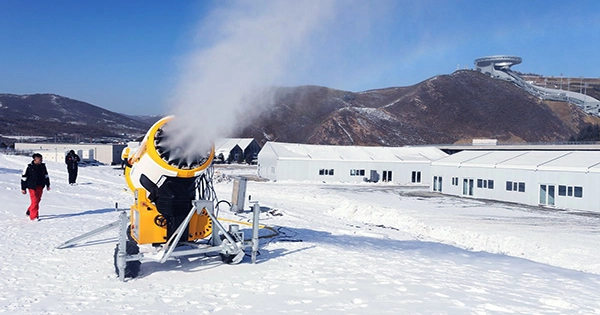The climate problem isn’t only horrible because it causes flowers to blossom early and turns Mad Max from a science fiction franchise into a frighteningly accurate prophecy. It will also impact how we watch sports in the future: the Winter Olympics will most likely be held on fully manufactured snow in the future. We mean “beginning now” when we say “the future.” According to a report from Loughborough University London, the 2022 Beijing Winter Olympics will be the first time without a single flake of natural snow on the ground – it will be almost entirely artificial.
The executive summary of the research states, “The lack of natural snow at Beijing 2022 is not surprising.” “The beautiful slopes outside Beijing hide a terrible truth: they’ll be the product of an estimated 49 million gallons of chemically treated water frozen by snow machines, an energy-intensive procedure that’s costly and potentially harmful in water-stressed places.” The organizers are installing eight water cooling towers, 130 fan-driven snow generators, and roughly 300 snowmaking guns to cover the proposed competition surface of around 800,000 square meters (about 8.6 million square feet). The Games will necessitate the creation of around 1.2 million cubic meters (317 million US gallons) of artificial snow – all in one of the world’s most water-scarce cities.
As you might expect, that will necessitate an enormous amount of energy – and will be “both costly and… a considerable strain on water resources,” according to the paper. This is true “even if powered by renewables,” according to the authors, and if China develops a massive new winter sports tourism business, which will almost certainly rely on artificial snow, this could be just the start of the problem. Man-made snow creates more dangerous competitions for winter athletes, which isn’t simply bad news for environmentalists.
Last month, Estonian Olympic biathlete Johanna Taliharm told AP that artificial snow is icier, making it faster and more dangerous. “It also hurts worse if you fall outside of the course on a rough and muddy hard ground rather than a fluffy snowbank.” Because man-made snow is generated from frozen water droplets sprayed at high speeds using a snow cannon, it isn’t truly snow at all. It isn’t created from regular six-pointed flakes like the kind that falls from the sky, so it lacks the natural air pockets that keep the slopes fluffy and dry.
Instead, because of its high water content, it can become slick, “like a hockey rink when there’s hockey snow,” according to slopestyle rider and 2018 gold medalist Red Gerard. He went on to say, “It’s just shaved ice.” “It feels like that’s what you’re riding on.” “Artificial snow is less merciful if you fall,” British snowboarder Zo Gillings-Brier told the Loughborough paper. “There is less snowfall than there was 20 years ago,” she remarked, “and more tournaments are cancelled due to lack of snow.”
One of those competitions may wind up being the Winter Olympics themselves if the climate issue continues to unfold as it is. According to the paper, rising temperatures would decrease prospective Winter sports locations to a collection of “smaller, more isolated venues,” some of which may have “inadequate infrastructure, a lack of tourist facilities, and poorer levels of accessibility.” Only six of the 19 recent host cities will be able to host the Winter Games by 2080, according to academics, and Beijing will not be one of them. According to the report, Canadian freestyle skier Phillipe Marquis said, “The circumstances are clearly more dangerous than what we’ve seen before.”
“The amount of water required to manufacture considerable amounts of [artificial] snow to secure early season venues is mind-boggling from an environmental aspect.” “Yes, artificial snowmaking has always provided a boost, but we’ve reached an inexorable crossroads where artificial snowmaking is now carrying a huge load,” he continued. “Where do you think we’ll be in five years?” What’s ten years? “Fifty years?” you might wonder.















